Competitor analysis is a crucial part of digital marketing.
When you know what your rivals are up to, you can make more informed marketing decisions and better understand your target market.
While some companies obsess over paid and organic traffic analysis, one area of market research is often overlooked: social media.
In this article, we’ll look at why it’s beneficial to pay attention to social media metrics, explore what they can reveal about your competitors’ strategies, and—most importantly—explain how you can gain these valuable insights.
Why Social Media?
Monitoring your competitors’ social performance is useful because it reveals what may or may not work for you. You can evaluate growth opportunities across different channels and niches simply by seeing how audiences react to your rivals’ content. This, in turn, allows you to create a more effective social strategy of your own, resulting in more audience engagement and increased brand awareness.
It also provides you with insights into the best practices for content creation and output. For instance, what kind of voice and tone does your shared audience like to engage with? What types of content do they prefer? Knowing the answers to these kinds of questions can save you a lot of time and resources.
Why Do I Need Tools?
You may be wondering why you need tools for this; surely you can just follow your competitors’ accounts to see what they’re up to, right?
In practice, though, it’s extremely time-intensive to manually track all your rivals’ account activity. Tools mitigate this, allowing you to focus your resources on other tasks, as well as providing you with data that you can’t access manually (such as engagement rates and longer term trends).
For example, Semrush’s Social Tracker monitors a huge database of social media business accounts.
Social Tracker does all the heavy research lifting for you and provides data-driven insights on your social media competition.
That’s a lot of leg work covered—and a lot of valuable data—at a low cost.
You can learn more about using Social Tracker with our in-depth guide.
Analyzing Your Social Media Competition
So, now that we’ve covered the “why," it’s time to focus on the process of analyzing your social media competitors.
Let’s say that you’re building a sleep product brand and you want to grow your social share of this $432B global industry. After some market research, you identify Casper as your largest rival, and now you want to start challenging their dominance.
Here are five steps you can take to help make this happen.
1. Identify Your Competitors’ Most Engaging Content
Creating and testing your social content can be time consuming and resource intensive. Learning how to engage with your target audience can be a hit-and-miss process and result in missed opportunities while you try to find your social media feet.
However, analyzing your rivals’ best performing content can make your life a lot easier. By looking at the posts that perform for your rivals, you can get an idea of the best practices and then apply them to your own. You can even take creative inspiration if you’re struggling for ideas (although it’s not a good idea to just outright copy what your competitors are doing).
So, how can you do this?
Let’s say that you’ve identified Instagram as a suitable marketing channel and you want to know what kind of posts work well there for Casper before creating your own.
Put Zara’s domain into Social Tracker and then select the “Instagram” tab. Immediately, you can see which posts have attracted the most engagement during your chosen time period.
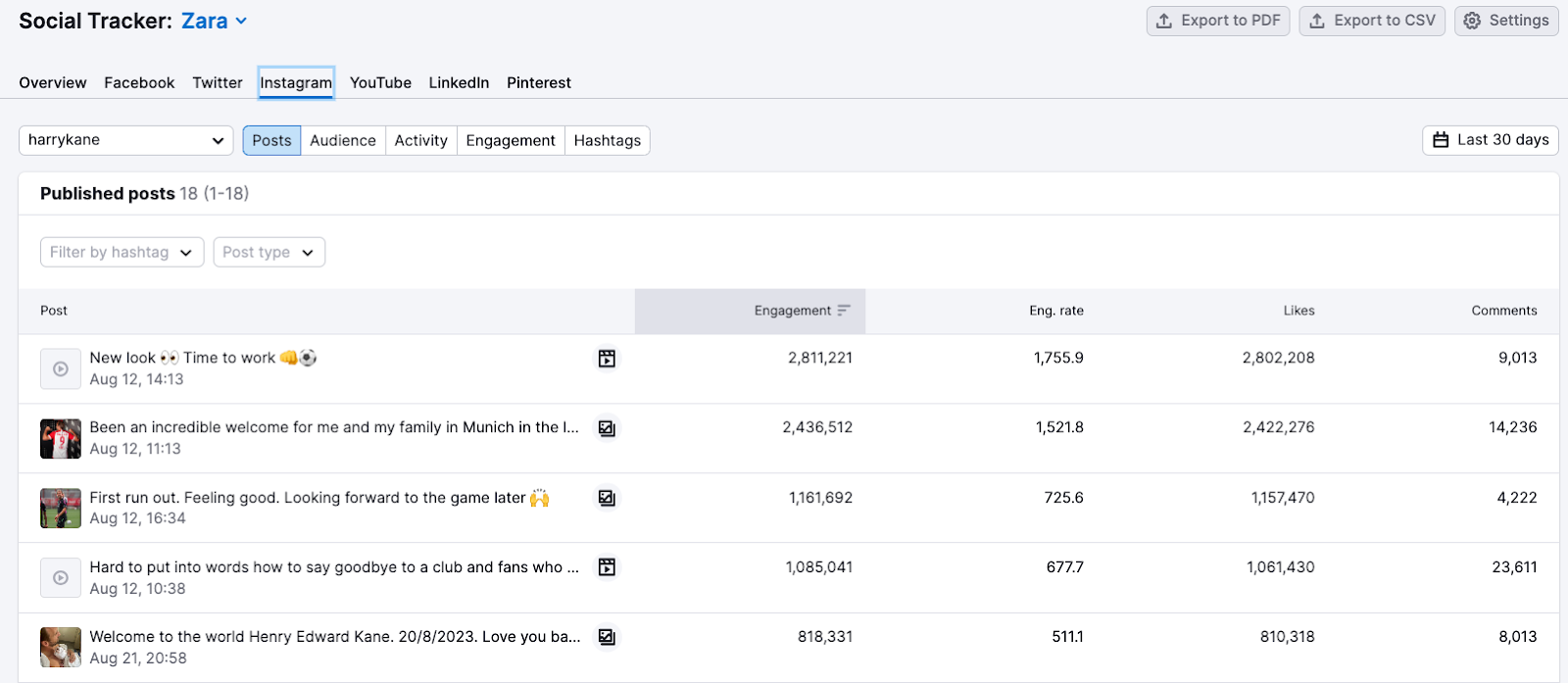
The two key metrics to note here are:
- Engagement, which, for Instagram, is the total number of likes and comments on a post
- Engagement rate, which measures the engagement on a post in relation to the number of followers
You can sort the posts based on these metrics and then view the posts themselves, allowing you to dissect what exactly Casper’s audience on this platform like to see. Once you’ve done this for several of your other competitors, you’ll have developed a pretty clear picture of what engaging, high-performing content should look like, giving you a proven framework for creating your own posts.
2. Uncover Your Competitors’ Best Performing Hashtags
Whether you love ‘em or loathe ‘em, hashtags are a crucial part of social media strategy. They help new users find your account, so you need to choose them carefully when publishing your posts.
Numerous tools are available that can help you select relevant and trending hashtags, but it’s just as valuable to know what’s performing for your competitors too. While branded hashtags may not be applicable, industry-specific ones certainly are, and you don’t want to miss out.
To find them, go into Social Tracker and select the “Hashtags” tab. We can see a list of Zara’s top performing hashtags (for that platform), as well as information on how often they’ve been used.

To get some more context and see how Zara has used these hashtags in their posts, switch to the “Posts” tab. You can then filter by hashtag to see the posts themselves, as well as insights on how those posts performed.
3. Analyze Your Competitors’ Posting Schedules
You can potentially increase engagement on your posts simply by posting at the right time. After all, when your audience is active, they are more likely to see your content and interact with it.
To discover the best days and times to post, you can look at your competitors’ schedules and engagement data. Go to the “Activity” tab in Social Tracker and check out the “When posts are published and people engage with content” report.
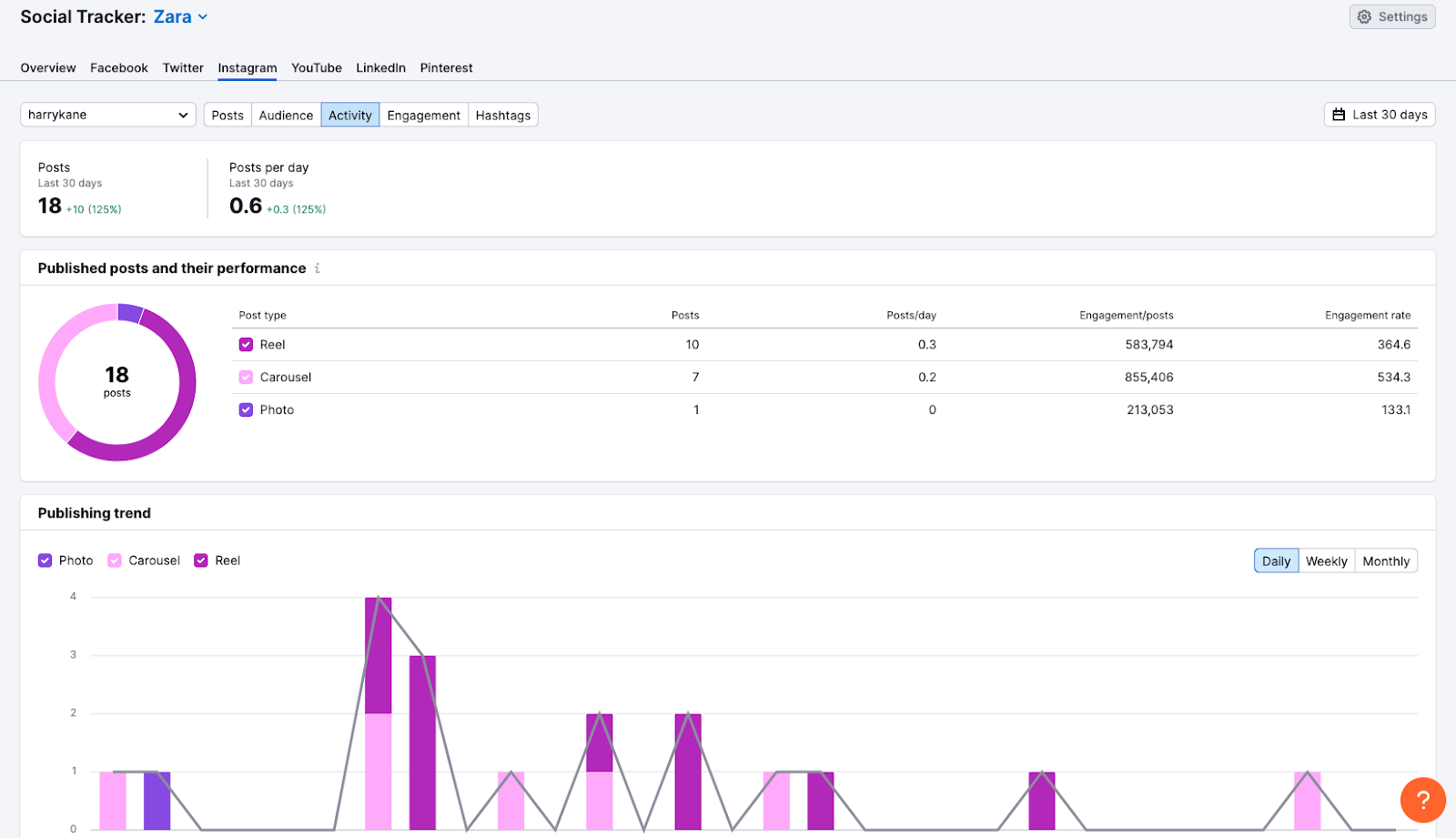
The report above shows that Zara receives the highest level of engagement on Mondays (even though it doesn’t often publish posts on this day). Conversely, posts receive a low level of engagement on Fridays (even though most of Zara’s posts are published on this day).
Therefore, as a competitor of Zara, you might consider scheduling your posts on Mondays (and Thursdays, as engagement is also high on this day), as this is when your shared target audience is most active.
4. Uncover Your Competitors’ Paid Social Strategies
As well as reviewing your competitors’ organic social strategies, it’s a good idea to look at their paid campaigns. This allows you to analyze the copy and promotions they are using to try and hook potential customers, as well as find inspiration for your own campaigns.
With Meta Ads Library, you can see all your competitors’ active ads for free. For this, let’s use Casper as an example.
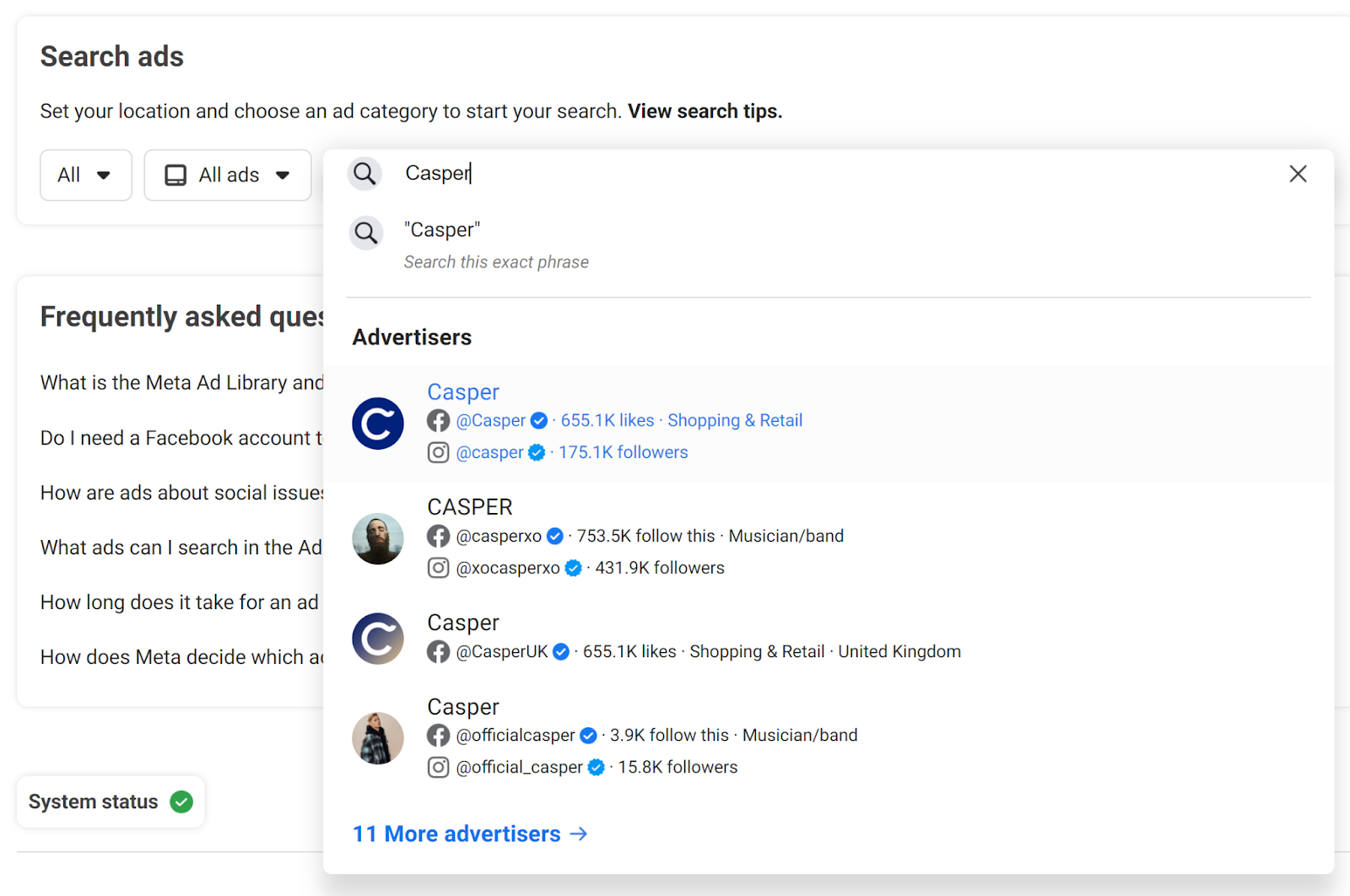
Enter Casper in the search bar and you’ll be able to see its currently live ads.
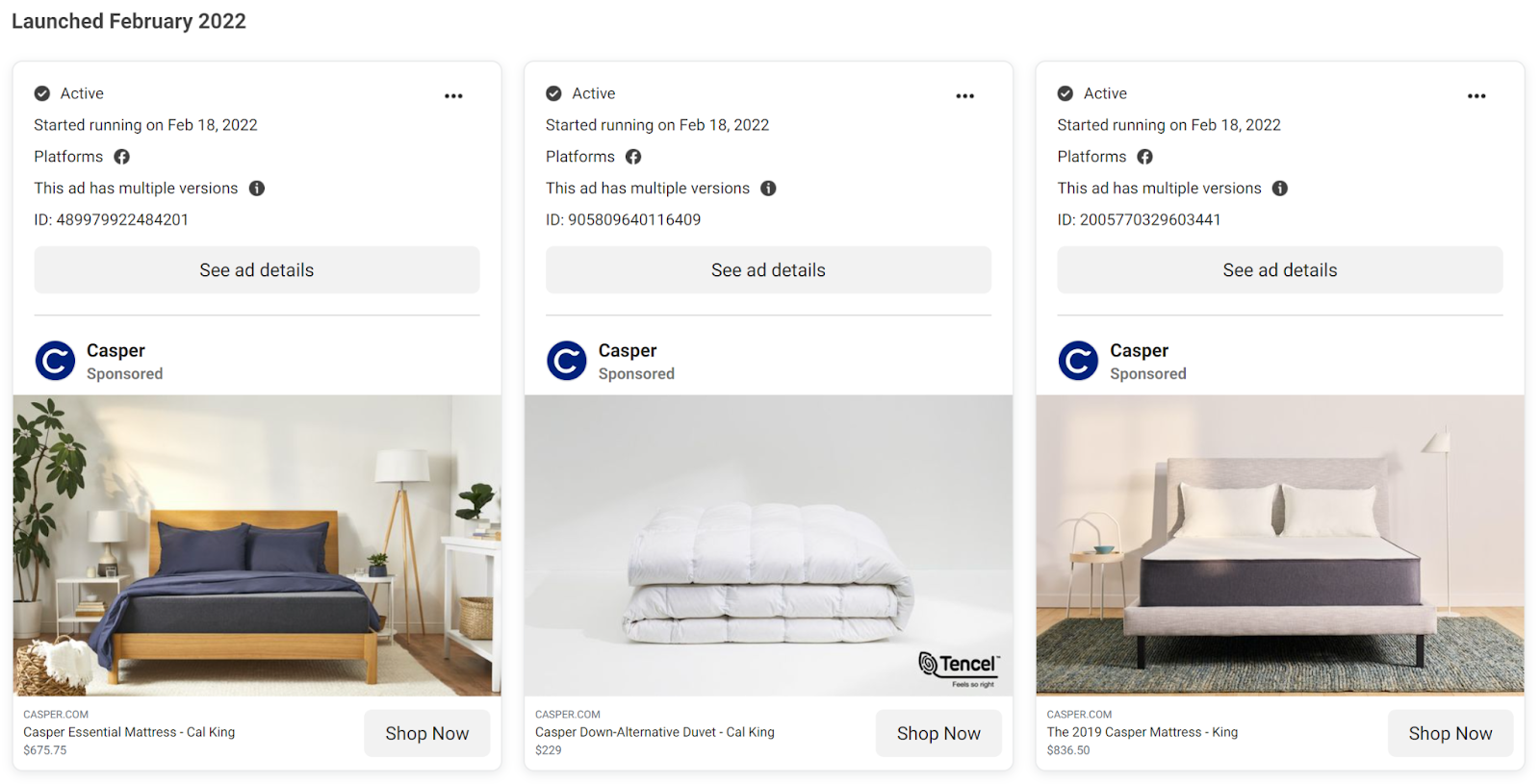
You can explore by region to see country-specific campaigns, as well as filter by:
- Media type (images, videos, memes, and text)
- Platform (Facebook, Instagram, and Messenger)
- Language
- Date range
Seeing these creatives allows you to scrutinize your own ads and identify the products, promotions, and keywords that Casper and your other rivals are currently focusing on.
5. Understand Your Competitors’ Long-Term Goals
Monitoring your rivals’ current campaigns has plenty of benefits, but to remain competitive going forward, you need to try and understand what their long-term strategy is.
For instance, what channels are they targeting for growth? Where are they trying to build a sustainable and visible presence? This is important to know, because if your competitors are present on a particular channel, you need to be too.
The comparison feature in Social Tracker helps you to answer these questions. For example, we can see in the “Comparison with competitors” report below that Acaai.org has slightly increased its Facebook presence, which would suggest that it may have identified growth opportunities on that platform.

Example.com, meanwhile, seems to be targeting X as a growth platform.

We can see that all competitors but one have increased their audience on Instagram. As a rival of these companies, it’s fair to say that strengthening your Instagram presence would be an urgent priority.

You can also compare specific trends, such as engagement levels over a certain period. For example, we can see below that Example.com saw a huge rise in engagement just before Labor Day, even though they’re posting activity did not increase. It could be worth looking more closely to see how Example.com achieved this, especially if you are planning your own seasonal campaigns.


These reports allow you to benchmark your output and your results as well as give you a much clearer idea of where you may need to improve or focus more resources.
Save Time and Spend Less
As mentioned, all of these reports can be obtained for a low fee while saving you a lot of time in the process. They can give you valuable insights into your competitors’ social media activities, ensuring that you always remain one step ahead.
With Social Tracker, you can also receive regular updates on how your competitors are behaving, meaning you only need to configure your report once. Simply click “Settings” in the top right corner of the dashboard and select the “Email reports” tab to set it all up.
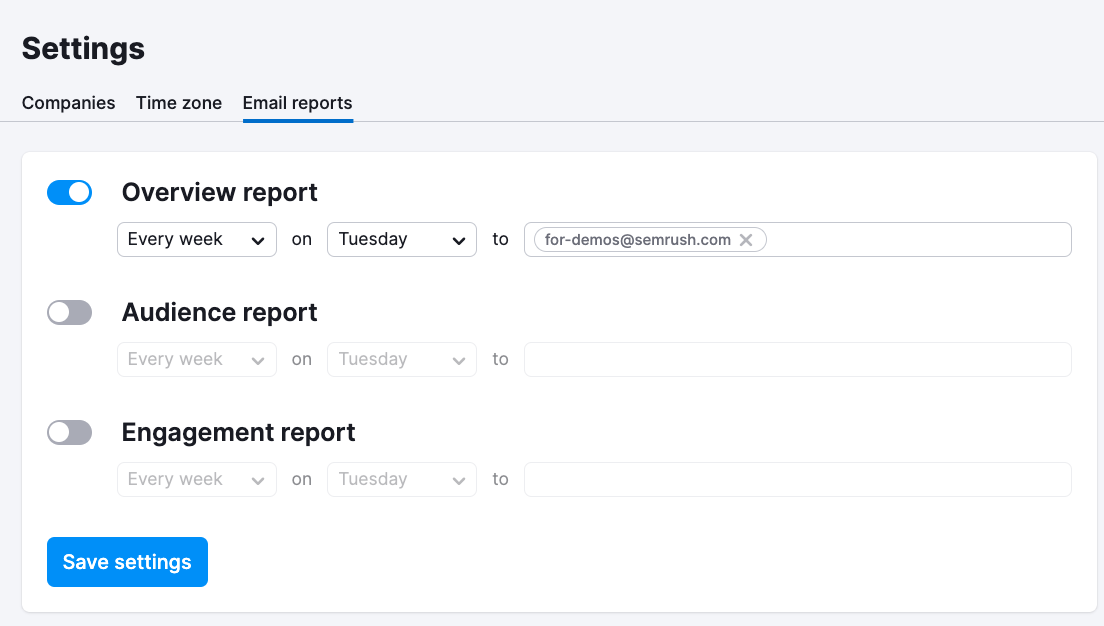
Armed with all these tips and insights, you can now start conducting your own competitor analysis, and begin to lay the groundwork for an effective and targeted social media strategy of your own. Whether you’re competing against established players in a $432B industry, like this one, or local rivals in a smaller niche, Semrush Social can help you be competitive—and successful—in your own battle of the brands.
Still not sure?
Check out our instant tracker tool and analyze one of your competitors right now.
Alternatively, you can learn more about Social Tracker before you dive in.
